
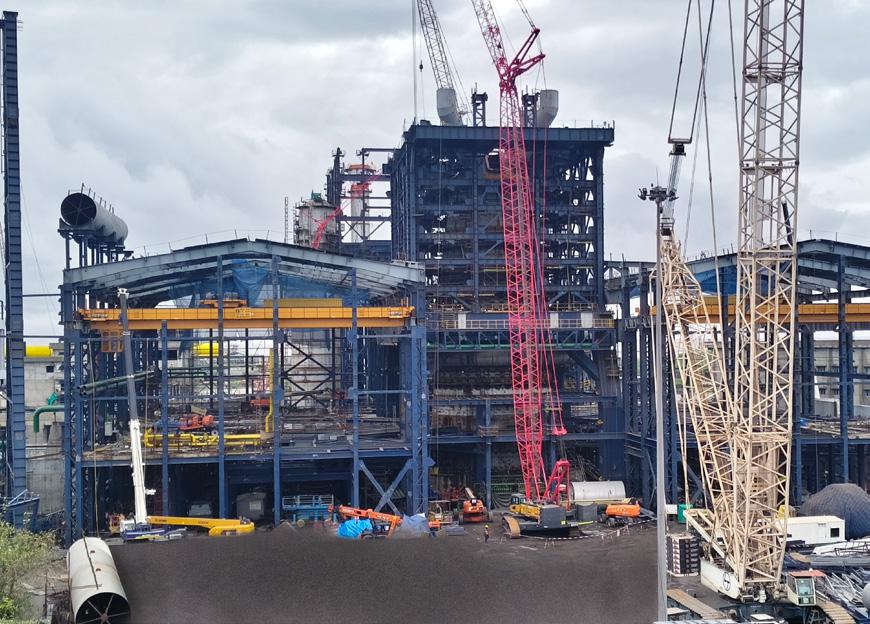
Blast Furnace 2
A dedicated team from the Minerals & Metals IC is pouring every ounce of energy into the mega 6 MTPA Steel Plant expansion projects for ArcelorMittal Nippon Steel (AMNS) at Hazira which involves building two of most technologically advanced Blast Furnaces of 4,500 cum. each having a production capacity of 3.5 MTPA each, a Steel Melting Plant of 6 MTPA capacity consisting of three 350 MT/ heat BOF Converters, 2 sets of 350 MT twin station Ladle Furnaces, two twin strand Slab Casters of 3 MPTA each, two sets of twin KR stations, 1 set of RH Degasser Unit and 3 sets of Dry GCPs.
“At the heart of our project is a powerful convergence of modular construction, advanced pre-planning, innovative work methods and technology integration,” remarks Task Force Leader (TFL), R. Suresh Kumar (RSK), “which is enabling the team to operate with agility, accuracy, and assurance at every phase of the project lifecycle. We are, in fact, shifting paradigms in the steel sector,” he adds grandly.
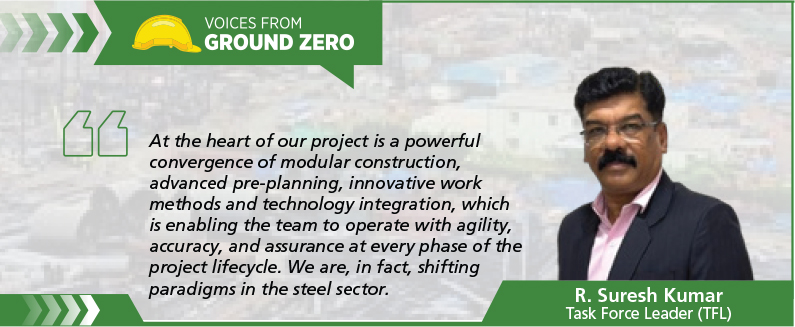
Engineering speed through Modularisation
The modular construction that RSK is referring to fast-tracks delivery, improves build quality, enhances safety, reduces high-risk site activities and minimizes disruptions in one of the most congested and constrained working spaces. The team has adopted a modular approach to accelerate critical path activities while simultaneously improving constructability & speed of erections.
Erecting the Blast Furnace Tower Structures involve preassembling the 5160 MT critical tower structures for each furnace offsite as multiple large modules at the fabrication yard at AMNHEC, Hazira, developed exclusively for the AMNS Hazira projects. These modules comprise intricate large control assemblies, welded connections, and precision interfaces, all meticulously designed to align seamlessly onsite with minimal adjustments and faster erection with high safety and quality standards. “Erecting these modules in fewer and larger lifts both reduced the number of crane hours used and significantly cut down high-risk man-hours spent at height,” points out a pleased Safety In-charge, Satish Chandra Yadav, “This approach has resulted in a safer, faster, and cleaner construction front.”
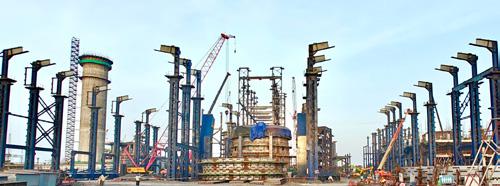
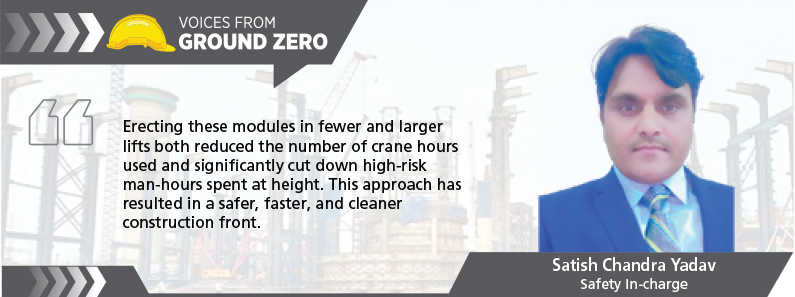
Building the Stock House for each furnace involves over 9300 MT of structural work comprising 62 bunker girder modules of 3510 MT, hoppers of 1114 MT, floor decks, roof structures, crane girders, etc. that were prefabricated at the fabrication yard and precisely assembled onsite. The long bunker girders weighing 140 MT each and the short bunkers of 47 MT each were also assembled and erected in single piece modules using high-capacity erection cranes, a first of its kind for M&M IC in any of the BF projects. “Instead of following a linear path, we had concurrent work streams for fabrication, transport, and erection,” highlights Project Manager, R J Shenoy. “By erecting the modules in sequence, we achieved tighter quality control and better interface management with the upstream and downstream packages,” adds young Planning Manager, Sunny Kumar. Aditya Vinayak Deshpande, the young and meticulous planner of the team, whose structured approach has significantly contributed to project progress, agrees whole-heartedly.
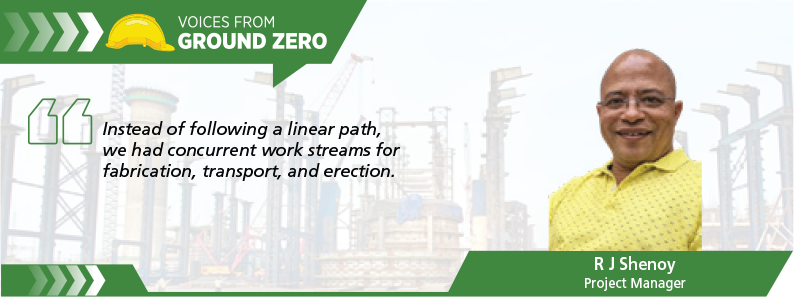
The massive Steel Melting Plant #3 structures are being fabricated in sub modules and erected likewise, a strategy that has not only benefited L&T in reducing the cycle time of the assembly but also enabled the team to plan the erection of bigger modules that are being attempted for the first time.
Precasting the Emergency Overhead Water Tank: “Modular precast execution has made its maiden appearance in the M&M IC for a water-retaining structure of the 74-metretall Emergency Over Head tank of 2300 cum capacity for better finish, speed, and structural integrity,” says a proud Arup Kumar Ray, Project Manager (Civil Works, AMNS projects). Unlike conventional cast-insitu techniques which demand extensive formwork, working at height, curing time, finishing, and are labour-intensive, this modular approach streamlines the entire process. To facilitate safe handling and precise installation, modular transport frames and lifting beams were specially designed for these large segments and the elements precast at site to reduce the time and cost of transportation. “Not only did precasting meet all the contractual performance parameters but also reduced execution time, all thanks to our robust preplanning and flawless execution,” says a satisfied Arup. “The sprinkling type curing arrangement adopted in slipform work of EOHT in the BF#3 project, using perforated pipes earned the AMNS Quality Control team’s appreciation and significantly mitigated the curing challenges encountered during formwork movement for the tall structure,” says Laxmi Motghare, the young & promising face of the civil execution team.

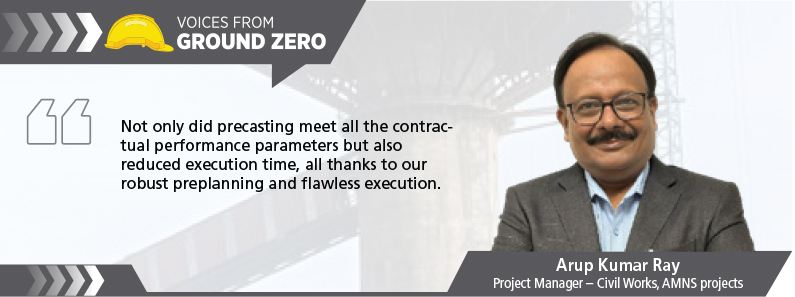
Unique achievements in concreting, deep excavation, equipment assembly & installation
“The fastest single and continuous pouring in the history of the Indian Metals industry was executed at par with international safety, quality and project management standards completing 5083 cum of concreting for the BF#3 proper foundation in 24 hours,” shares a delighted BF#3 Project Manager, Shastha Kiran Manai, referring to their remarkable milestone.
The proximity of all the three projects to the Arabian Sea threw up several challenges during excavation like the continuous ingress of water due to the water table being (-) 1 m below ground level. Despite which the SMP#3 project team successfully excavated the most critical structures, the scale pit (-22 m) and the torpedo pit (-15 m), by deploying the latest technologies to protect the piling works, including multi-level strutting and continuous dewatering of the excavated areas using deep well & well point methods, that speaks volumes of the technical competency of the civil construction team when concreting the deep structures with speed, safety and quality. These won appreciation from AMNS too.
On the equipment erection front, SMP#3 boasts of successfully completing assembly and installation of three 350 MT BOF Converters in a span of 4 months, a unique achievement for M&M IC thanks to the meticulous planning and execution skill of the equipment erection team. Critical Lamella welding for converters was completed in 12 days without any defects that too won appreciation from AMNS and the technology providers.
Challenges are nothing when sustainability leads the way: In a pioneering milestone for the IC, 205 60 m long end bearing piles of 1000 mm diameter were successfully driven for the Blast Furnace proper foundation, located adjacent to the Arabian sea, a landmark engineering effort undertaken to meet the challenging geotechnical exigencies of the Blast Furnace#3 site.
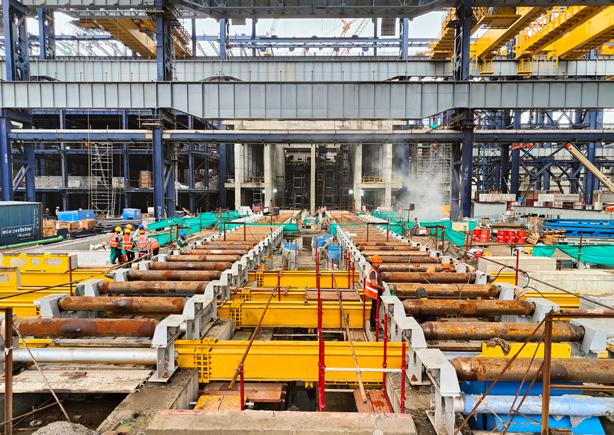

Steel Melting Plant 3
“Cognizant of the substantial environmental implications – with each 60 m pile potentially displacing nearly 100 cum of bentonite slurry which is not ecofriendly – we preemptively shifted to Polymer based soil stabilization, ensuring a sustainable, space-efficient, and eco-friendly execution,” points out Construction Manager (Civil), Sumeet Garg.
“Engineering excellence is defined not merely by outcomes, but by the ingenuity, foresight, and integrity embedded in execution” says the veteran leader Arup Kumar Ray, summing up the team’s efforts.
Not just planning … exceptional pre-planning
The team’s exceptional preplanning has found expression in their successful modular construction, in addition to efficient logistics orchestration, starting with the fabrication yard, located 9 km away from the main project site. “While the layout of the yard was optimized to facilitate movement, sequencing, and temporary storage of the modules, every activity from cutting steel plates to loading the final module was digitally tracked and synchronized with erection schedules to ensure zero idle time between yard dispatch and site erection,” informs Planning Head, Srinivas Pabolu.
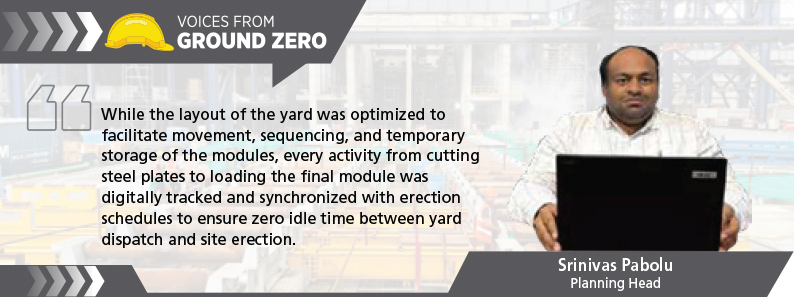
Transporting Over-Dimensional Components (ODC), some reaching lengths of up to 20 m and weighing over 100 MT, required detailed road surveys, structural clearances, route planning, road reinforcement, escort vehicles, and night permissions. Srinivas Vijjavarapu informs that local authorities were consulted months in advance, and a dedicated logistics team ensured smooth night-time convoy movements.
The modular strategy demanded early identification of lifting schemes, alignment methodologies, and interface management. The planning team worked closely with the yard engineers to ensure that each module was fabricated, considering lifting and handling. Detailed lifting plans integrated with 3D models were developed by the structural engineers to validate stability, rigging configurations, and compatibility with available crane capacities. Each module was issued with its own handling documentation, ensuring zero surprises at site.
Critical contribution of timely supplies
Equipment and structural supplies play a pivotal role for timely completion, successful commissioning and handover of such mammoth and complex Blast Furnaces and Steel Melt Plants. “Swift placement of orders for major equipment pave the way by providing crucial load data inputs for civil & structural engineering, which, in-turn, leads to early commencement of civil and structural works at project sites,” informs Arghya Ray Chaudhuri, Head (Engineering and Supply Coordination), who is responsible for ensuring on-time supply of all equipment as well as building and technological structures across all three projects at AMNS, Hazira.
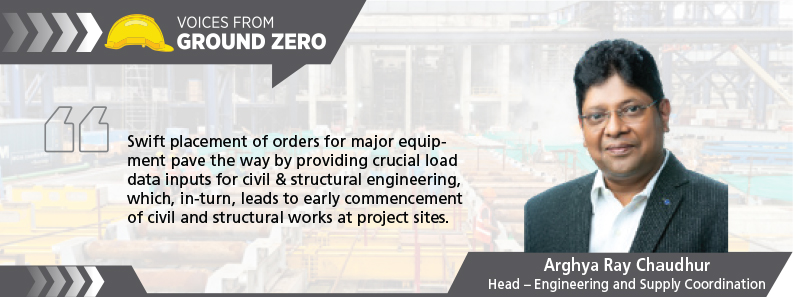
Driving the digital advantage
The Hazira Projects are underpinned by a robust digital ecosystem facilitating end-to-end visibility, predictive decision-making, and agile response. “Digital tools have been integrated across the fabrication, transport, site operations, safety, and quality functions, to create a truly connected construction environment,” says Ajitabh Shah, Head – Resource & Digital.
With a workforce of over 12,000 deployed across various fronts, it was crucial not just to ensure manpower availability, but also that they were optimally skilled and compliant with all safety protocols. The WISA platform has proven invaluable, serving both as an induction tool for workers and a system for tracking their skill profiles and certifications. WISA’s skill-mapping dashboard provides daily insights to front-line supervisors, helping them to assign crews based on skillsets, experience, and real-time availability.
The CONQUER App provides a digital interface for conducting quality inspections, tracking RFIs, generating pour cards, and managing NCRs that are geo-tagged and time-stamped to form an auditable trail for project quality. Escalations are automatically routed to responsible engineers, reducing delays and enhancing first-time-right metrics.
A network of IoT-enabled machines continuously monitors critical operational metrics such as runtime, fuel efficiency, maintenance cycles, and operator productivity. Crane movements, lifting sequences, and idle times are fed into a central dashboard, to throw up utilization analytics, for planners to reassign equipment based on priority and performance.
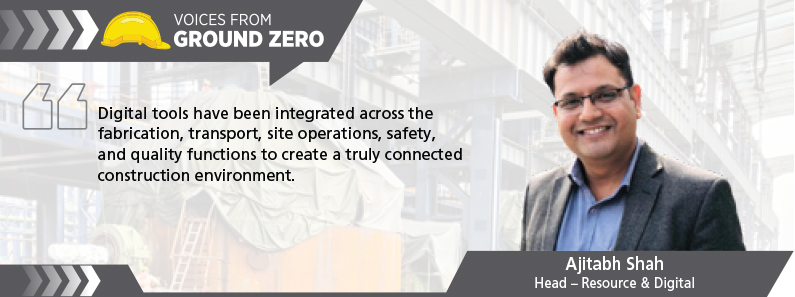
“Everything from fabrication progress, logistics, crane schedules, weather windows, and safety observations to modular arrival are tracked on our integrated dashboards to ensure total visibility for all our stakeholders to adhere to dynamic project milestones,” Ajitabh emphasizes. Additionally, visual trend analysis enables predictive planning for resource shifts, shift scheduling, and safety focus areas.
More than building structures; it is about synchronization
The Hazira team must efficiently manage modular arrivals, crane availability, erection crew readiness, and safety in parallel for which the project planning team is transforming complex modular strategies into executable field plans. “The Planning Cell is our nerve centre of operations that integrates fabrication timelines, transport constraints, crane resources, front readiness, constant realignments as per requirement and multi-level coordination,” elaborates R. Sivanesan, Project Director of SMP#3 Project.
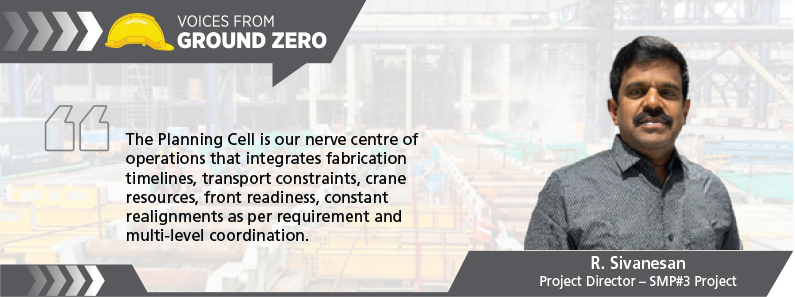
Each module is tracked on a digital planning board that maps yard readiness, dispatch schedules, transit status, site storage, and erection sequencing. Color-coded trackers empower zone leads to quickly spot critical interfaces and upcoming dependencies. Lookahead schedules are reviewed daily and updated weekly, with rolling forecasts covering over 300 modules. Visual planning tools and collaborative platforms facilitate cross-stream integration across civil, mechanical, structural, and safety functions. Regular alignment meetings leverage BIM models and digital Gantt charts to visualize space constraints, crane swing radius, and concurrent activity zones.
Risks associated with sequencing delays or scope creep are identified early, with mitigation plans embedded into the master schedule. A centralized dashboard provides realtime comparisons between planned and actual progress, highlighting deviations with root-cause indicators enabling swift corrective actions and adaptive rescheduling. As Srinivas Pabolu aptly summarizes, “We adhered to the principle that if it isn’t on the plan, it won’t be on the ground. Real-time updates and visual planning boards help us stay on track despite moving targets.”
Executing at safety: safely & precisely
“Each lift is a performance,” quips Rakesh Pandey, Construction Manager. “Pre-alignments, lifting rehearsals, and interface walkdowns make it smooth, safe, and successful,” adds Biplab Karmakar, Project Manager.
Erecting the massive tower, stock house & SMP#3 modules demanded exceptional discipline in execution. Every lift was pre-simulated using 3D models to verify centre of gravity, clearances, slinging plans, and crane interactions. Detailed lift plans included wind load assessments, ground bearing pressure checks, and contingency scenarios for weather-related interruptions.
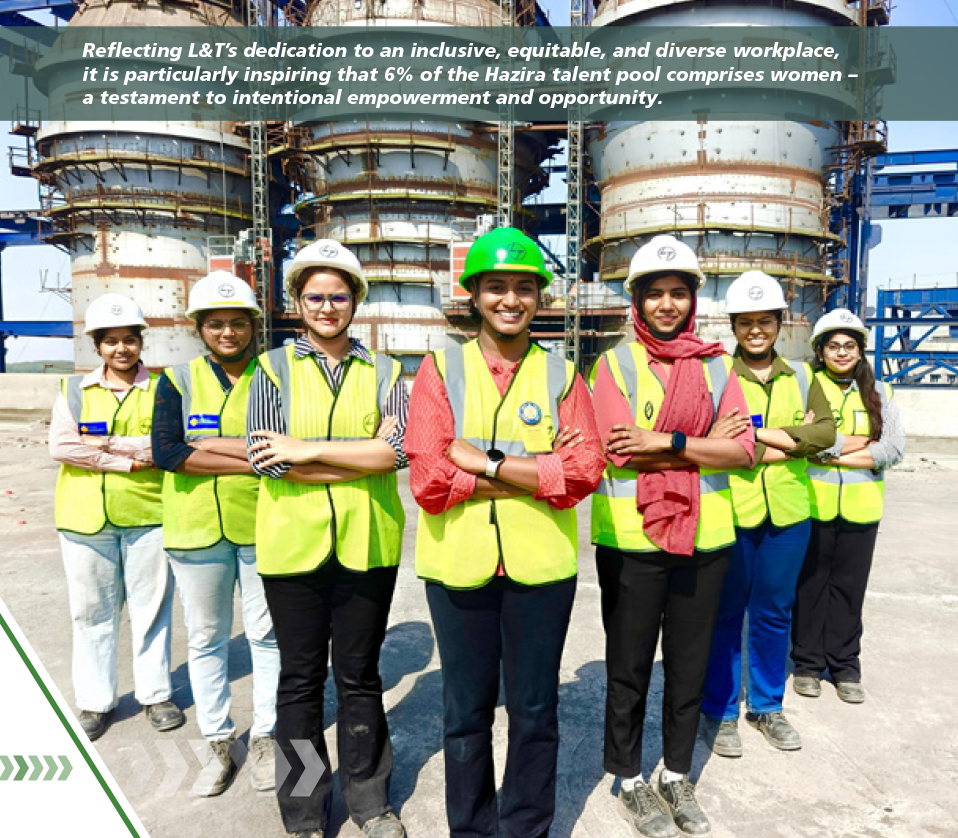
Scaffold-free erection methods using engineered lifting frames, modular access systems, and custom alignment brackets have improved worker safety and consistency, and minimised manual intervention. Specially trained rigging crews handle tandem lifts, load shifting, working within narrow clearances.
A proactive safety-first approach involves daily pre-job briefings, comprehensive risk assessments, and leadershipled interface walkdowns to reinforce safety protocols and acknowledge exemplary practices. Toolbox talks are customized to address specific job hazards identified during risk mapping, fostering targeted safety awareness. Daily safety audits are conducted using a mobile inspection app, streamlining the process and enhancing real-time compliance tracking.
First time right: Maintaining quality is the key for the team installing the two twin caster stands with associated facilities including water lines and hydraulic systems in collaboration with technology provider, Danieli Corus, to the satisfaction of AMNS. Reacting to the client’s appreciation, Project Manager (Caster and utility System), Suman Mukherjee declared, “We are extremely proud having demonstrated innovative ideas and adopted modularization technique in lifts of critical structures resulting in substantial reduction in work at height.”
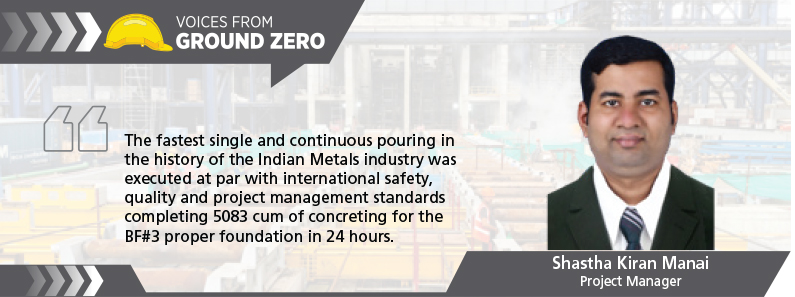
Jai Shankar, Project Manager (Piping) informs that his team is fully geared to install one of the most complex utility systems including an emergency overhead tank, three cooling towers and a common water pump house along with almost 15,00,000 m of piping with its complex layout and various interface issue with existing facilities.
In conclusion, Project Director of Blast furnace projects, A Dhanasekar emphasizes, “We have successfully cultivated a culture of planning, innovation, and excellence, which is instrumental in meeting our project timelines. Our continuous effort is to construct faster, smarter, and more efficiently, delivering a model of speed, safety, and scale, underpinned by our various technology interventions.”
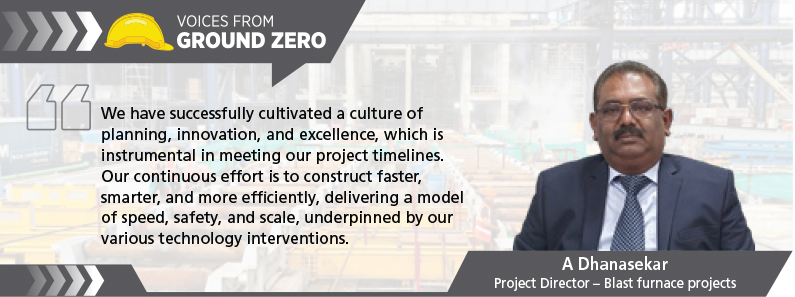
An extraordinary team effort: Success, at the AMNS Hazira site, stems for a heady mix of meticulous planning, flawless execution, unwavering commitment and collaborative spirit. Reflecting L&T’s dedication to an inclusive, equitable, and diverse workplace, it is particularly inspiring that 6% of the Hazira talent pool comprises women — a testament to intentional empowerment and opportunity. Unified in purpose, the team is fully mobilized and prepared to deliver all three critical packages with precision and excellence. Their cohesive drive underscores the extraordinary effort guiding this landmark endeavour. “We are here to take M&M IC and L&T forward,” declared young planning engineer Aisha Hussain, who is determined to walk the distance to turn hers and that of the entire team into a successful story.